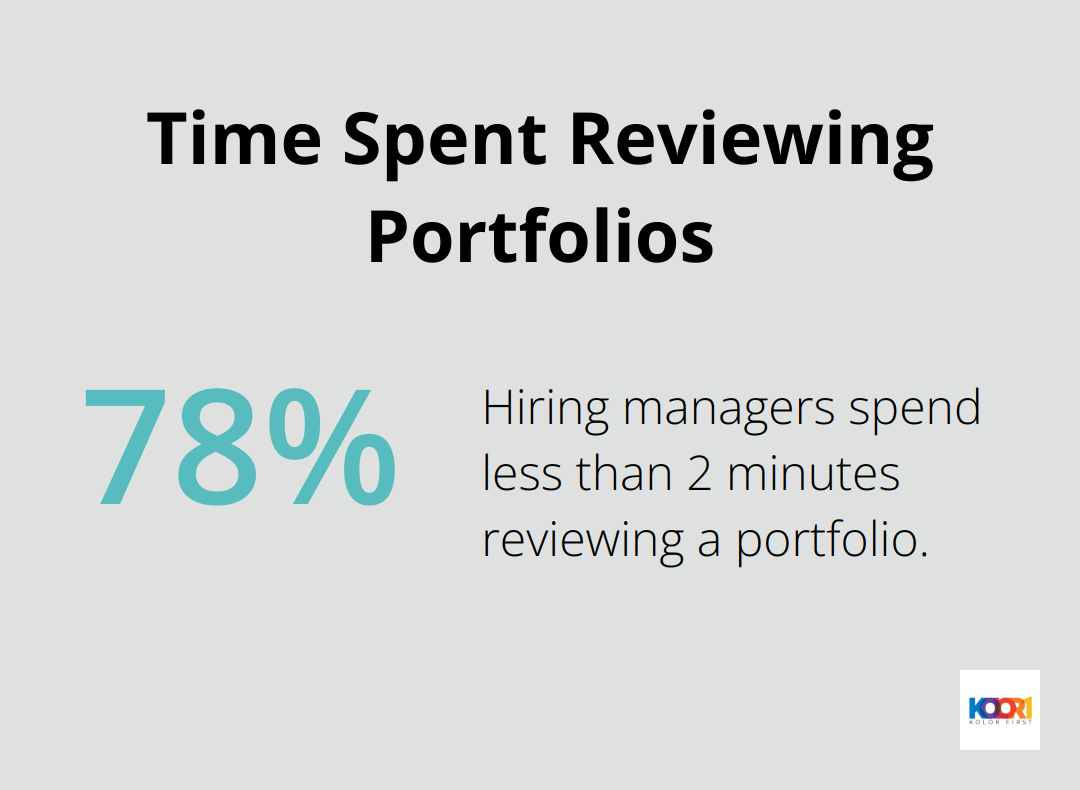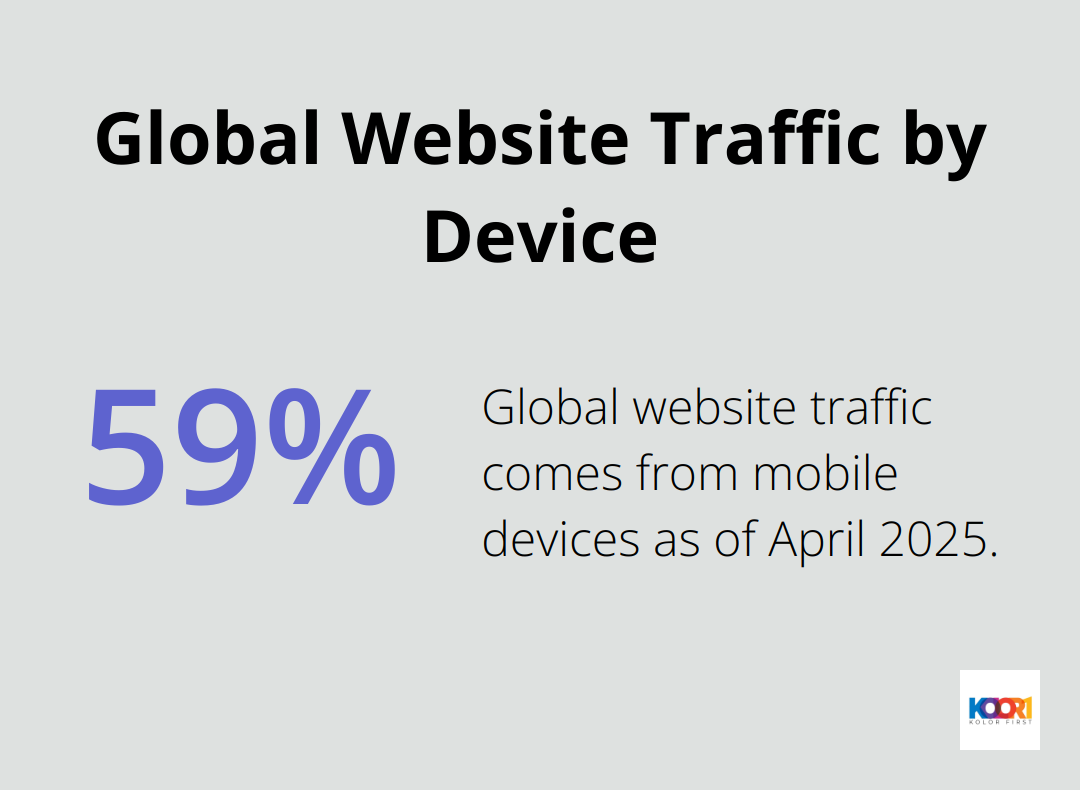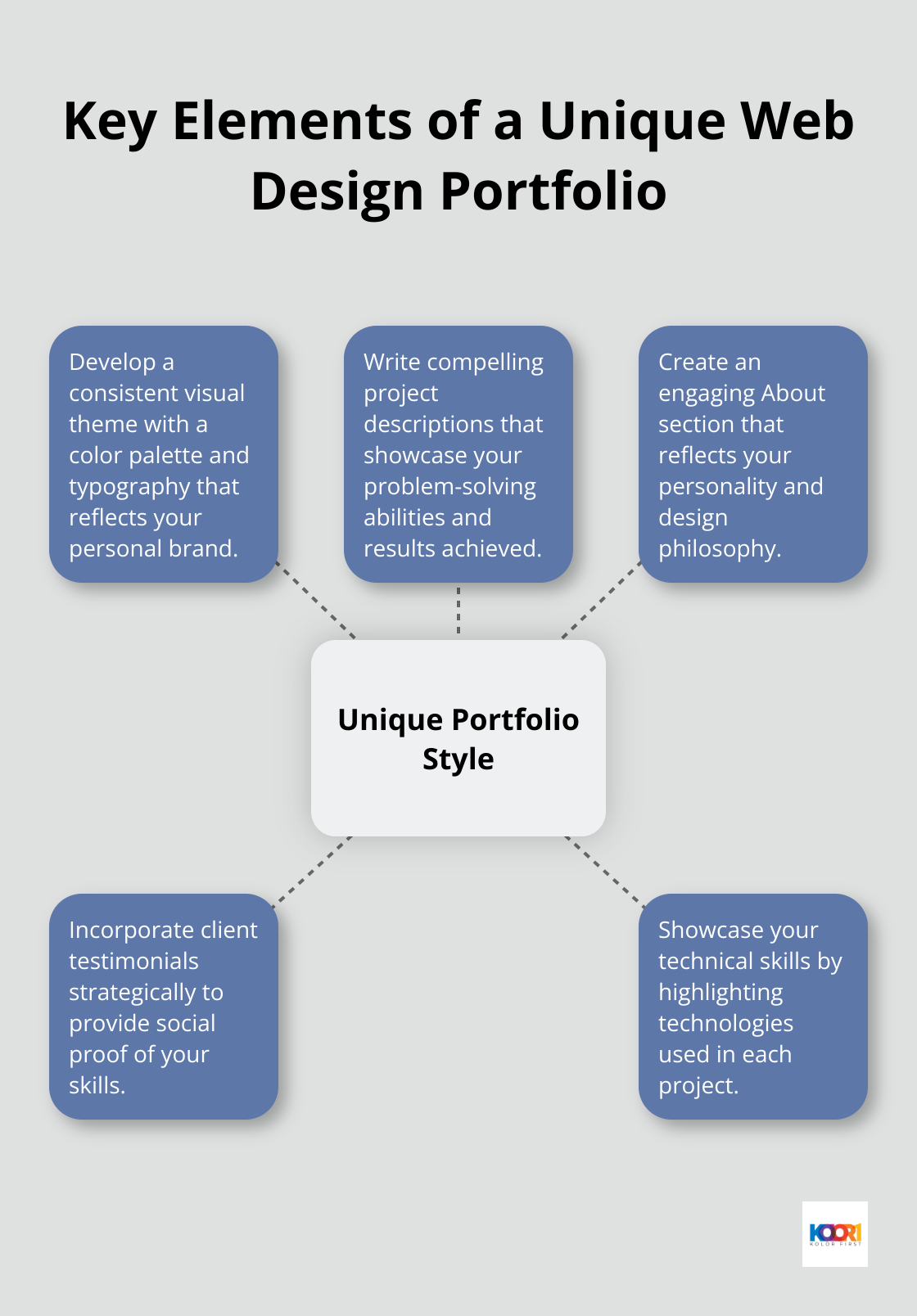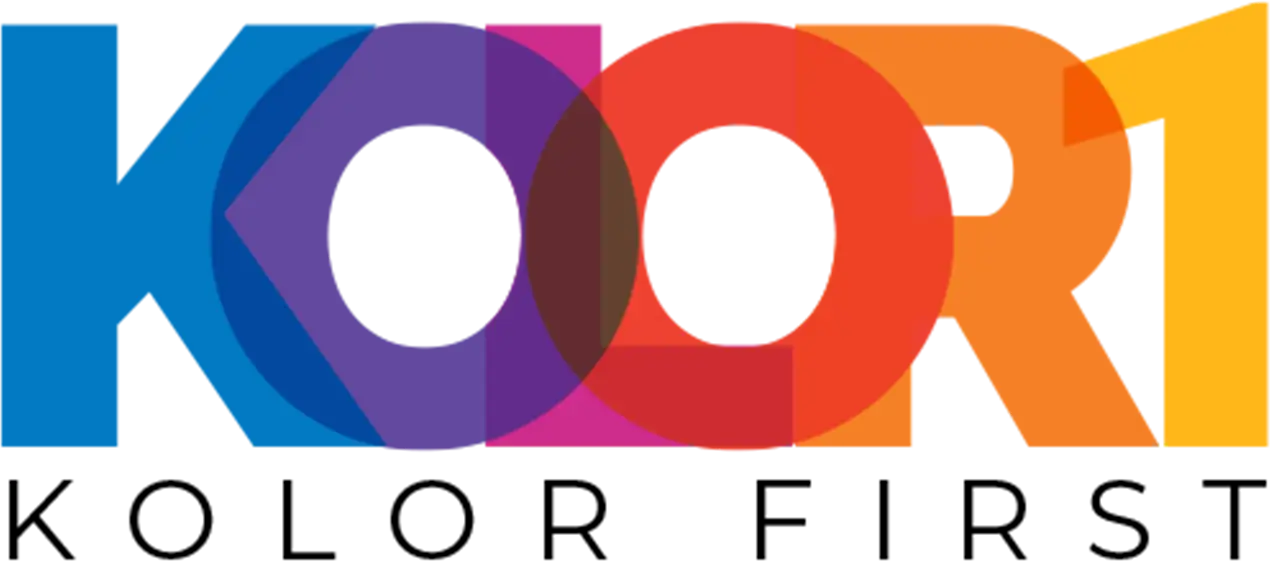At Kolorfirst LLC, we know that a stunning web design portfolio template can make or break your career prospects. A well-crafted portfolio showcases your skills, creativity, and unique style to potential clients and employers.
In this post, we’ll guide you through the essential elements of creating a portfolio that stands out from the crowd. We’ll cover everything from selecting your best work to optimizing your site for maximum impact.
What Makes a Web Design Portfolio Stand Out?
Curate Your Best Work
Quality trumps quantity in portfolio design. Select 3-5 of your strongest projects that represent your skills and style. These should be recent works that align with the type of clients you want to attract. A 2024 survey by DesignCensus revealed that 78% of hiring managers spend less than 2 minutes reviewing a portfolio, so make every project count.

Diversify Your Showcase
While specialization has value, demonstrating versatility can open more doors. Include a mix of project types – e-commerce sites, landing pages, mobile apps, and branding work. This variety shows potential clients that you can adapt to different needs and industries.
Tell the Story Behind Your Designs
Don’t just show the final product. Walk visitors through your design process. Explain the problem you solved, your approach, and the results achieved. Use before-and-after comparisons when possible. UX research methods are crucial in creating detailed case studies that can effectively showcase your work.
Prove Your Technical Prowess
In web design, aesthetics and functionality go hand in hand. Highlight your coding skills by mentioning the technologies you used in each project. If you’ve worked with popular frameworks like React or Vue.js, make sure to showcase this. According to Stack Overflow’s 2024 Developer Survey, knowledge of these frameworks can increase your market value by up to 20%.
Optimize for User Experience
Your portfolio should not only look good but also provide an excellent user experience. Try to create a clear navigation structure, implement responsive design, and optimize for fast loading times. A well-designed portfolio (with intuitive navigation and quick load times) can significantly increase engagement and time spent on your site.
Now that we’ve covered what makes a portfolio stand out, let’s explore how to craft an engaging layout that will captivate your audience and showcase your work effectively.
How to Design an Engaging Portfolio Layout
Simplify Navigation for Better User Experience
Create a clear, intuitive navigation structure. A study by the Nielsen Norman Group found that 94% of users want easy navigation on websites. Place menus in conventional locations – typically at the top or left side of the page. Use descriptive labels for your menu items. Replace vague terms like “work” with specific categories such as “Web Design” or “Branding Projects.”
Embrace the Power of Grid-Based Design
Grid systems provide a framework for organizing content that’s both visually appealing and functional. They create a sense of order and help guide the viewer’s eye through your work. Tools like CSS Grid or frameworks such as Bootstrap can help you implement a responsive grid system efficiently. Using CSS Grid to place UI elements helps to position them precisely which is beneficial for implementing responsive design for the site.
Prioritize Mobile Responsiveness
Mobile devices account for about 59.7% of global website traffic as of April 2025, so your portfolio must look great on screens of all sizes. Implement a mobile-first approach by designing for smaller screens initially and then scaling up. Use flexible images and fluid grids to ensure your work looks crisp on any device. Test your portfolio on various devices and browsers to catch any responsiveness issues.

Speed Up Your Site for Better Engagement
Page speed is a critical factor in user experience and SEO. Google’s PageSpeed Insights tool can help you identify areas for improvement. Optimize images, minify CSS and JavaScript, and leverage browser caching to boost loading times. A Portent study showed that conversion rates drop by an average of 4.42% with each additional second of load time between 0-5 seconds.
Your portfolio’s layout should complement your work, not overshadow it. Keep the design clean and focused, allowing your projects to take center stage. These strategies will help you create a portfolio that not only showcases your skills but also demonstrates your understanding of effective web design principles. Now, let’s explore how to infuse your unique style and personality into your portfolio to make it truly stand out.
How to Infuse Your Unique Style into Your Web Design Portfolio
Creating a portfolio that truly represents you involves more than just showcasing your work. It’s about infusing your unique style and personality into every aspect of your portfolio. Here’s how you can make your portfolio stand out:

Develop a Consistent Visual Theme
Your web design portfolio should reflect your unique style and personality. Select a color palette that resonates with your personal brand and apply it consistently across your site. Consider using black colors for primary texts and icons, grey shades for secondary texts, icons, and strokes, and an accent color for buttons and other elements. Choose colors that reflect your style and attract the type of work you want.
Typography plays a key role in your visual identity. Pick fonts that complement your design style and ensure readability across devices. Limit your selection to two or three typefaces for consistency.
Write Compelling Project Descriptions
Present your work with engaging narratives. Explain the client’s challenge, your approach to solving it, and the results achieved. Include concrete metrics where possible (e.g., “redesign increased conversions by 25%”).
Transform each project into a mini case study. This approach showcases your design skills and demonstrates your problem-solving abilities and business acumen.
Create an Engaging About Section
Your About or Bio section allows your personality to shine. Write in a tone that reflects who you are-professional, quirky, or somewhere in between. Share your design philosophy, background, and what motivates you as a designer.
Include a professional photo of yourself. This personal touch helps potential clients connect with you on a human level.
Incorporate Client Testimonials
Add client testimonials throughout your portfolio. These serve as powerful social proof of your skills and reliability.
Place testimonials strategically near relevant projects or on your homepage for maximum impact. If possible, include the client’s name, company, and photo to add credibility.
Showcase Your Technical Skills
Highlight your coding abilities by mentioning the technologies you used in each project. If you’ve worked with popular frameworks like React or Vue.js, make sure to showcase this.
Your portfolio is a marketing tool designed to attract your ideal clients. Infuse it with your unique style and personality to create a memorable experience that sets you apart from the competition (including other agencies like Kolorfirst LLC).
Final Thoughts
A stunning web design portfolio template showcases your skills and attracts potential clients. You should curate your best work, tell compelling stories behind your designs, and optimize for user experience. This approach will create a portfolio that stands out in a crowded market and leaves a lasting impression on potential clients.
Your portfolio must evolve with your career. You need to update it regularly with new projects and skills to stay relevant in the fast-paced world of web design. Continuous learning and improvement are essential to success in this field. You should attend workshops, take online courses, and engage with the design community to expand your knowledge.
At Kolorfirst LLC, we understand the importance of a strong portfolio in the competitive world of web design. Our team of experts can help you create a portfolio that reflects your skills and attracts your ideal clients. We’re here to guide you every step of the way, whether you’re just starting out or looking to revamp your existing portfolio.






